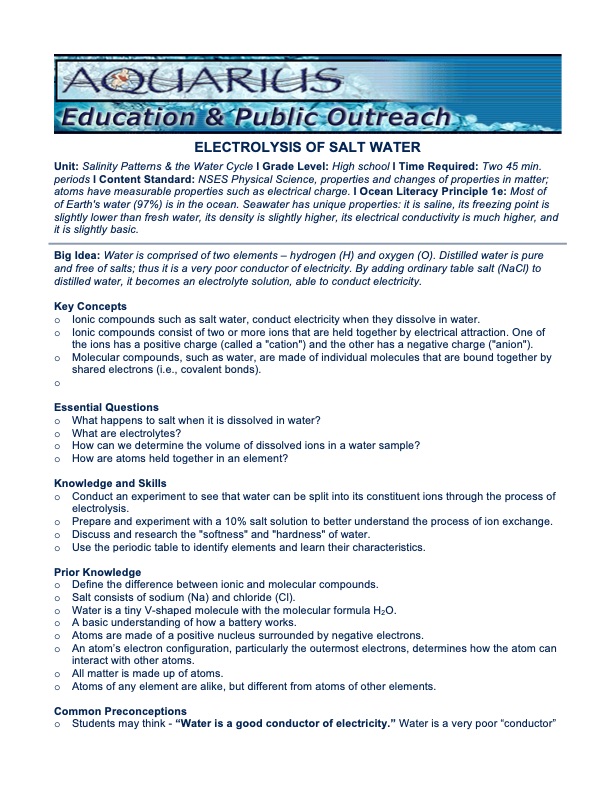
PDF Publication Title:
Text from PDF Page: 001
ELECTROLYSIS OF SALT WATER Unit: Salinity Patterns & the Water Cycle l Grade Level: High school l Time Required: Two 45 min. periods l Content Standard: NSES Physical Science, properties and changes of properties in matter; atoms have measurable properties such as electrical charge. l Ocean Literacy Principle 1e: Most of of Earth's water (97%) is in the ocean. Seawater has unique properties: it is saline, its freezing point is slightly lower than fresh water, its density is slightly higher, its electrical conductivity is much higher, and it is slightly basic. Big Idea: Water is comprised of two elements – hydrogen (H) and oxygen (O). Distilled water is pure and free of salts; thus it is a very poor conductor of electricity. By adding ordinary table salt (NaCl) to distilled water, it becomes an electrolyte solution, able to conduct electricity. Key Concepts o Ioniccompoundssuchassaltwater,conductelectricitywhentheydissolveinwater. o Ioniccompoundsconsistoftwoormoreionsthatareheldtogetherbyelectricalattraction.Oneof the ions has a positive charge (called a "cation") and the other has a negative charge ("anion"). o Molecularcompounds,suchaswater,aremadeofindividualmoleculesthatareboundtogetherby shared electrons (i.e., covalent bonds). o Essential Questions o Whathappenstosaltwhenitisdissolvedinwater? o Whatareelectrolytes? o Howcanwedeterminethevolumeofdissolvedionsinawatersample? o Howareatomsheldtogetherinanelement? Knowledge and Skills o Conductanexperimenttoseethatwatercanbesplitintoitsconstituentionsthroughtheprocessof electrolysis. o Prepareandexperimentwitha10%saltsolutiontobetterunderstandtheprocessofionexchange. o Discussandresearchthe"softness"and"hardness"ofwater. o Usetheperiodictabletoidentifyelementsandlearntheircharacteristics. Prior Knowledge o Definethedifferencebetweenionicandmolecularcompounds. o Saltconsistsofsodium(Na)andchloride(Cl). o WaterisatinyV-shapedmoleculewiththemolecularformulaH2O. o Abasicunderstandingofhowabatteryworks. o Atomsaremadeofapositivenucleussurroundedbynegativeelectrons. o Anatom’selectronconfiguration,particularlytheoutermostelectrons,determineshowtheatomcan interact with other atoms. o Allmatterismadeupofatoms. o Atomsofanyelementarealike,butdifferentfromatomsofotherelements. Common Preconceptions o Studentsmaythink-“Waterisagoodconductorofelectricity.”Waterisaverypoor“conductor”PDF Image | ELECTROLYSIS OF SALT WATER

PDF Search Title:
ELECTROLYSIS OF SALT WATEROriginal File Name Searched:
electrolysis.pdfDIY PDF Search: Google It | Yahoo | Bing
Product and Development Focus for Salgenx
Redox Flow Battery Technology: With the advent of the new USA tax credits for producing and selling batteries ($35/kW) we are focussing on a simple flow battery using shipping containers as the modular electrolyte storage units with tax credits up to $140,000 per system. Our main focus is on the salt battery. This battery can be used for both thermal and electrical storage applications. We call it the Cogeneration Battery or Cogen Battery. One project is converting salt (brine) based water conditioners to simultaneously produce power. In addition, there are many opportunities to extract Lithium from brine (salt lakes, groundwater, and producer water).Salt water or brine are huge sources for lithium. Most of the worlds lithium is acquired from a brine source. It's even in seawater in a low concentration. Brine is also a byproduct of huge powerplants, which can now use that as an electrolyte and a huge flow battery (which allows storage at the source).We welcome any business and equipment inquiries, as well as licensing our flow battery manufacturing.| CONTACT TEL: 608-238-6001 Email: greg@salgenx.com | RSS | AMP |